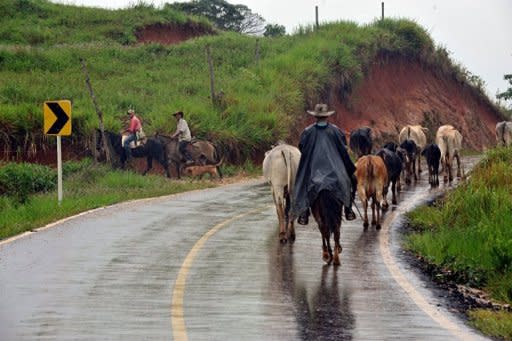Colombia's 'red zone' ensnares French journalist
Between the Andes and the Amazon jungle, in a rebel stronghold called "the red zone," French journalist Romeo Langlois has become ensnared in Latin America's oldest armed conflict. Everyone in this municipality has heard of Langlois and how he was captured by Colombia's leftist FARC guerrillas April 28 during a firefight that broke out while he was on a reporting assignment with a Colombian army unit. "Here appearances are deceptive. It looks like a paradise and all of a sudden it becomes a hell. The guerrillas are always a threat. Unfortunately this reporter found out the hard way," said Roosbelt Figueroa, a 39-year-old farmer, on a dirt road that rain has turned to mud. Ten years ago, the Revolutionary Armed Forces of Colombia (FARC), which was set up in 1964, forced 90 families to flee the nearby village of Triunfo, not far from where the clash occurred that ended in Langlois's capture. Today only five families live there. "You French are unlucky," said an inhabitant of Union Peneya, the nearest village to the clash, alluding to the kidnapping of former presidential candidate Ingrid Betancourt in 2002. A dual French-Colombian citizen, Betancourt was kidnapped some kilometers from Union Peneya and held hostage for more than six years by the FARC. The FARC's Front 15, a group of about 300 fighters supported by an estimated 2,000 non-combatants, claimed responsibility for Langlois's capture, and said they were holding him as a "prisoner of war." His capture has not been confirmed by the FARC's high command, but a top Colombian army commander said while the army could not vouch for the authenticity of the rebel claim, "it's the most credible version." "If Romeo is not with us, or in a hospital and we haven't recovered his body, that means that they are holding him," said General Javier Rey, the commander of the army's aviation wing. The 35-year-old journalist, who was working on a report for France 24 television, had previously reported extensively on the armed conflict in Colombia. "He's an impetuous boy who wanted to show the true face of the FARC and that it no longer has anything to do with communism. He's paying for it now," said Rey, who authorized Langlois's embedding in the military patrol that came under attack. Rey said Langlois was with about 30 soldiers who were left by helicopters at a large supply center at dawn near Union Peneya after dismantling a cocaine refining lab in the jungle. Surprised by their arrival, a force of about 200 guerrillas attacked, setting off the firefight. "The two soldiers protecting Romeo were killed. After six hours of shooting, from 10 meters apart, he got up and surrendered," said Rey, adding that bad weather prevented the army from sending in reinforcements to drive off the attackers. Even for a well-equipped division with 7,000 soldiers, the rainy season complicates operations in this hilly region with roads so poor that it can take an hour to travel 10 kilometers (six miles). To encourage the guerrillas to release the journalist, the army on Wednesday suspended military operations in the area, which doesn't sit well with all soldiers. "It makes it more complicated for us, and they are taking advantage of it," said a soldier at a checkpoint. But most of the region's inhabitants said they felt sorry for the French journalist. Jorge Antonio Vallejo, a 35-year-old cattleman, said: "Weapons rule here, and they rule badly. But Romeo was unarmed and he did not deserve to lose his freedom."



